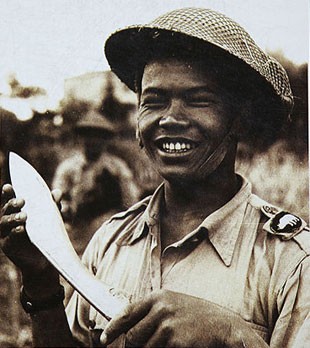
HISTORY OF THE KHUKURI
The Khukuri’s history predates the founding of the nation of Nepal. When the kingdom of Nepal was first created in the 16th Century, it was already the weapon of choice for the Gurkhas and their predecessors, the Nepali Sainik (warriors or soldiers).
The khukuri is ancient - Many believe that its 2,500-year history stretches back to at least the time of Alexander the Great’s invasion of the Indian subcontinent, and this is certainly possible. However, historians are not completely sure if Alexander brought the blade with him to what is today Nepal, or if he and his cavalry troops encountered it here on the battlefield, realized its effectiveness, and adopted it for themselves.
It is even possible that both stories are true: The Macedonian version of the kopis (the term used for the single-edged, reverse-curved sword used by Alexander’s cavalry) was strangely SHORTER than its Egyptian counterparts – interestingly enough, about the size of a khukuri. Whatever the circumstances were, though, they remain lost to history.
In any case, the present curved khukuri design as we know it today was born as an object of native craftsmanship in the hills of Nepal, in or around the 7th century BC - about 2500 years ago.
To put this into some sort of defining historical context, the Japanese katana is justifiably famed as the iconic sword of Japan’s fabled samurai warriors… But it is also true that when the great Japanese master craftsman, Amakune, made the first gracefully curved katana sword for the samurai, some 900 years ago, the art of crafting the khukuri was already more than a thousand years old.
The Nepalese khukuri has the unique distinction of being the only ancient battle weapon still in use in the field today – a distinction that is unique in the entire history of edged weaponry.
The khukuri first gained notoriety in the West for its ferocious effectiveness against the British troops who encountered it in the Anglo-Nepali War.The mutual respect each side gained for the other in that war forged the British-Gurkha alliance that continues to this day.
This emblematic weapon continued to serve the Gurkha warriors who wielded it through World War I, and World War II. During these conflicts, the knife gained high regard among allied and enemy troops alike, for its effectiveness and utility.
Because a Gurkha and his khukuri are inseparable, it was formally adopted as official military issue gear under British leadership – each Gurkha carries one as a part of his “kit,” in both parade and battle. No Gurkha would ever think of going into combat without one. In this way, the khukuri has also become a part of English history as well.
The English spelling of the word, Khukuri, has been rather “fluid” over the years, owing to the fact that the English characters used must be interpreted phonetically from the Nepalese language – So the word, “Khukuri” has also been written, khookree, khukri, khukuri, kukery, kukoori, and kukri. Early British dispatches and other accounts render it in three syllables – “koo-ker-ee” – It even achieved a certain degree of 19th Century British literary fame, when – in Braham Stoker’s classic tale of horror, Dracula, one of the English heroes, the stalwart Jonathan Harker, beheads the evil villain with a single sweep of his “great kukri.”
But however, it is spelled, and whatever notoriety it has achieved elsewhere, it remains first and foremost the iconic, traditional battle knife of the Gurkhas.
The spelling of the kukri has been in dispute for some time. It has documented as khookree, khukri, khukuri, kukery, kukoori and kukri. There are mostly from early British accounts.tha spoken word is 3 syallable. Today’s accepted spelling are kukri or Khukuri. The kukri is the national weapon and icon of Nepal. It was and still is the basic and traditional utility knife of Nepalese, a formidable and very effective weapon of gurkhas regiment throughout the world and an exquisite piece of local craftsmanship that symbolic pride and valor. It is wickedly curved in shape. it is basically carried in leather case, mostly having walnut wooden grip with two small knives. It is part of many traditional ritual among different ethnic group of Nepal, including one where the groom has to wear it during the wedding ceremony. The khukuri gained fame in the anglo-nepali war fpr its effectiveness and its continued use right through to and including both world war Iand World War II, enhanced its reputation among both allied troops and enemy force. The oldest known khukari are in national museum (Kathmandu in Nepal and belonged to Drabya shah circa 1559